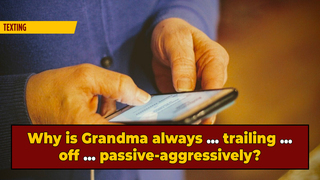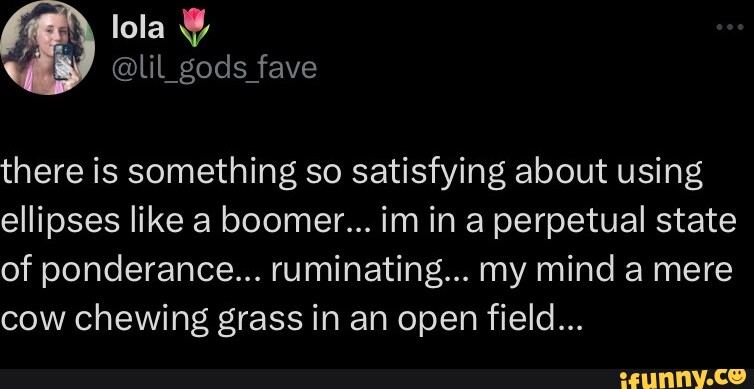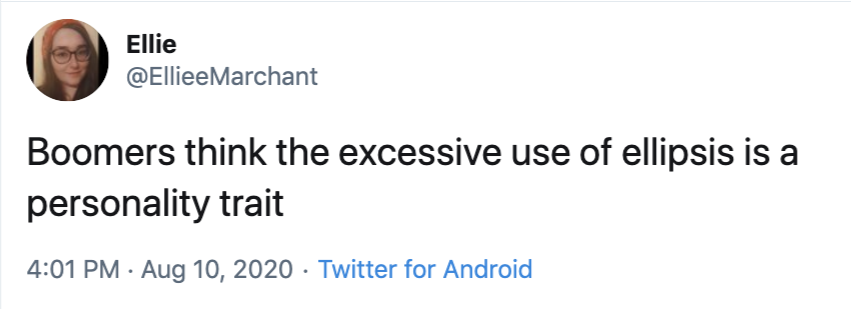
A Sense of Doubt blog post #3462 - Boomer (and Gen X) Ellipses... Are you talking TO ME?
Apparently both Baby Boomers and Gen X are accused by younger generations of using ellipses in confusing ways.
from
Maybe it's because we sort of came-of-age with stupid technology that transitioned from verbal to text? It's soooooo hard to me, still, to get the right "feel" in text. I don't know...the little dots just help man.
Not to sound like an old codger, but why do younger generations call everything passive aggressive? I was told last week that the thumbs up emoji is now borderline hate speech. Of course I replied "...whatever."
More defense
The use of ellipses (...) in place of other punctuation marks, such as periods, commas, or question marks, is a common phenomenon on social media platforms like Facebook, and it is not limited to just boomers and seniors. While it may not be exclusive to any particular generation, it can sometimes be more prevalent among older users who may not be as familiar with the conventions of online communication.
There are a few reasons why some people might use ellipses excessively in their online posts:
- Informality: Social media platforms are often more casual and conversational in nature, and some users may use ellipses as a way to convey a sense of informality or a more relaxed tone in their writing.
- Pause or Emphasis: Ellipses can be used to indicate a pause in speech or writing, or to create a sense of suspense or emphasis. Some users may use them as a stylistic choice to add a certain rhythm or flow to their posts.
- Uncertainty or Hesitation: In some cases, people may use ellipses as a way to convey uncertainty, hesitation, or a trailing off of thought. It can be a way to signal that there is more to say or that the thought is not fully formed.
- Lack of Familiarity with Punctuation: Some users, particularly those who are not as familiar with standard punctuation conventions or who may be typing on mobile devices, might use ellipses as a catch-all for various types of punctuation.
While the use of ellipses in place of other punctuation marks may not adhere to traditional grammar rules, it is important to recognize that language use is constantly evolving, especially in digital communication. Different people have different writing styles, and what may seem like incorrect or excessive use of ellipses to some may be seen as a valid form of expression by others.
In conclusion, the use of ellipses in place of other punctuation marks on social media is not necessarily an outdated grammar construction. It is more of a stylistic choice that some users make for various reasons, including informality, emphasis, uncertainty, or simply out of habit.
I've asked this myself more than once (older millennial), and have spent quite a bit of time talking to my elders, strangers and friends and family. Interpreting what I've gathered, it seems to stem from the technology divide. Younger folks, who have grown up with instant communication, autocorrect and emojis are used to rapid fire thought, delivered in lieu of face-to-face speech. It's fast, imprecise, and generally pretty forgiving…provided you know the lingo. If you didn't grow up with texting, predictive Google searches, memes and the like, electronic communication tends to fall in a void somewhere between writing a handwritten note and a term paper. It isn't formal, per say. But it isn't viewed as being as free and easy as younger people treat it. The ellipses (…) are intended to imply thoughtful pauses or to simulate the natural gaps that happen all the time in spoken conversation as speakers collect their thoughts and formulate a response. Young people see…this…(naturally) as words unspoken or subtextual cues (e.g. being passive aggressive). But elder folk use ellipses to give a visual cadence to what they are treating as conversational writing. As far as I can tell, it’s analogous to unspoken “ums," “hmms," and “huhs.”

The Ellipsis is Widening the Gap Between Millennials and Boomers. Here’s Why
https://www.purewow.com/tech/why-do-boomers-use-ellipses
Imagine you’re playing charades. You draw a card that prompts you to act out a phone conversation. What shape does your hand take? If you’re over the age of 15, you’ll probably extend your thumb and pinky fingers to create the surfer’s gesture and raise the symbol up to your ear. If you’re a young teen or kid who grew up surrounded by smart devices (rather than flip phones or handsets), you might curl your hand like you’re holding a brick or simply stretch your palm out flat before beginning your mimed chat. You’re probably also wondering, “What the hell is charades?”
The viral phone challenge stunned TikTok last year, with Millennial and Gen X parents watching in disbelief as their kids clutched pretend iPhones. But it’s not the first time the app has exposed these generational splits. Users have poked fun at Baby Boomers and their penchant for decorative signs encouraging us to “Live, Laugh, Love.” They’ve also cast Millennial women as “cheugy” for sporting side parts and clapping along to the Friends theme song.
And now, the people of TikTok have taken aim at older adults for a particular grammatical choice: Their puzzling use—and overuse—of the ellipsis.
“I emailed a professor to schedule a meeting to go over some classes and he replied with ‘Sounds good…we can meet then.’ I thought he hated me,” TikTok user @heyanoushka lamented in a viral video last month. “I will spend 10 minutes trying to interpret the tone of this ellipsis,” TikToker @megalybrak captioned a montage of e-mails from their manager. So what’s the deal with the ellipsis and why is it causing so much intergenerational confusion? We chatted with Gretchen McCulloch, Internet Linguist and author of Because Internet: Understanding the New Rules of Language, to learn more about the beloved Boomer punctuation and how the three dots are widening the age gap online.
The ellipsis has pre-internet roots
Turns out, people were sprinkling their phrases with ellipses long before texts and Facebook comments existed. A look back at casual written communication of the past—old postcards, recipe books and informal notes—clued McCulloch into the intended use of the punctuation. “When we think about informal pre-internet writing, space was at a premium. If you’re sending someone a postcard, but you only have a small box to write in, you won’t speak in full sentences,” she points out. To save real estate on the page, the writer would string together thoughts using ellipses and dashes, rather than penning longer, formal sentences with periods. You wouldn’t want someone to read your brownies recipe only to discover you didn’t have space to include bake time or cooling instructions, right?
But we no longer have to worry about running out of room on the recipe card. “It seems to be that using a dot-dot-dot imports an offline norm into an internet space,” McCulloch notes. The internet gives our words room to breathe. With the vast digital expanse at our disposal, we’re free to use as many line breaks as we’d like in e-mails or fire off 20 texts in a group chat. Run out of characters in a tweet? Simply pick up where you left off with a new tweet reply (or five). And as for that recipe? Write an entire essay about your childhood before getting to the instructions for the perfect double-chocolate brownie.
Why does it feel so foreign to younger people?
So why do the dots cause so much drama compared to the innocuous dash or comma? To the younger crowd—whose first words to their crush probably went down on Instant Messenger—the ellipsis has taken on an entirely different meaning. “For people who primarily use line breaks as a way of separating their thoughts, the dot-dot-dot is then available for another meaning, and that other meaning is something left unsaid,” McCulloch tells us. To Millennials, the three dots are a punctuational bridge to nowhere, signaling hesitation, trailing off or—at worst—passive aggression. “I can’t wait to see your presentation…” suggests a continuation the writer is thinking, but won’t actually come forward with, like, “…because it’s sure to be a disaster.”
Clearly, letting your reader fill in the blanks does more harm than good. “If you’re constantly assuming your boss is sending you messages with something left unsaid, you’re going to think, ‘Is my boss mad at me?,’ whereas your boss is just trying to be informal and relaxed,” says McCulloch. The ellipsis? Relaxed? We know, it’s hard to believe.
To older adults, digital communication doesn’t carry all the nuance
Although it’s unfathomable to younger generations, McCulloch says that most older adults aren’t sending digital messages with tone in mind. “People who use the ellipsis like that are not even aware that social media writing is capable of conveying passive aggressiveness and they’re definitely not being passive aggressive,” she explains. While Millennials are hyperconscious of how their digital communication is perceived (see: ensuring our emails have the correct exclamation-point-to-period ratio), this isn’t always the case for Baby Boomers, whose messaging skews more direct.
McCulloch tells us older adults think using an ellipsis is simply the correct form when it comes to informal speech. “The imagined audience for older people is not the actual people they’re writing to. Their imagined audience is still their memory of their grade-school English teacher,” she notes. For quick exchanges, you wanted your writing to sound like you were speaking. According to the “invisible grammarian” McCulloch says Boomers still have in mind, the proper way to bring together informal thoughts is with an ellipsis. “The dot-dot-dot is trying to be casual,” she stresses.
When in doubt, overcommunicate
As someone of either generation, how can we be more mindful of these communication quirks? Start by being open and accepting of all styles of online communication. McCulloch tells us to approach these punctuation differences like we're chatting with someone who has a different accent. “It’s not like one of them has to be right and the other has to be wrong. You don’t have to have one right answer, but it is really useful for people to be aware that this is a thing that a whole section of people do on a regular basis, so you know which kind of accent you’re communicating with in terms of digital punctuation style,” she explains.
And if you’re not clear on what someone’s really getting at in their text or Slack message, ask! “Have these overt meta conversations,” suggests McCulloch. “You can say, 'When you said this, were you mad at me?'" It’s better to have an honest chat than assume your father-in-law or co-worker secretly hates you. And if someone actually is frustrated with you, it’s their responsibility to convey their feelings through a direct conversation; not via a few dots in an e-mail.
This isn’t the first mix-up and it won’t be the last
The cool thing about colloquial language? It’s always changing. McCulloch reminds us of a time when internet newcomers typed in all caps. Remember calling your parents to explain that their text messages make it seem like they’re yelling at everyone? (Remember calling someone about anything, period?) McCulloch says it spurred larger cultural conversations, with explainer videos and memes surrounding the caps lock phenomenon. “Now, no one has to do that anymore because people do know that all caps is shouting,” she says.
More change across our keyboards is inevitable. Younger generations will usher in new forms of digital language, and we’ll all try to keep up. “We don’t want to get too hung up thinking we’ve discovered the right way to do things because we’re just going to get proven wrong again,” says McCulloch. So just wait. Before you know it, Generation Alpha (aka the iPad kids) will be eager to make fun of your “main character aesthetic” and that cat sweater you’re wearing ironically.
+++++++++++++++++++++++++++++++++++++++++++++++++++++++++++++++++++++++
+++++++++++++++++++++++++++++++++++++++++++++++++++++++++++++++++++++++
- Bloggery committed by chris tower - 2408.10 - 10:10
- Days ago = 3326 days ago
- New note - On 1807.06, I ceased daily transmission of my Hey Mom feature after three years of daily conversations. I plan to continue Hey Mom posts at least twice per week but will continue to post the days since ("Days Ago") count on my blog each day. The blog entry numbering in the title has changed to reflect total Sense of Doubt posts since I began the blog on 0705.04, which include Hey Mom posts, Daily Bowie posts, and Sense of Doubt posts. Hey Mom posts will still be numbered sequentially. New Hey Mom posts will use the same format as all the other Hey Mom posts; all other posts will feature this format seen here.





No comments:
Post a Comment